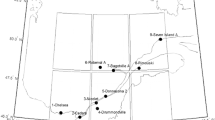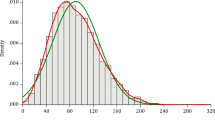Abstract
We propose a new method to estimate autoregressive model parameters of the precipitation amount process using the relationship between original and transformed moments derived through a moment generating function. We compare the proposed method with the traditional parameter estimation method, which uses transformed data, by modeling precipitation data from Denver International Airport (DIA), CO. We test the applicability of the proposed method (M2) to climate change analysis using the RCP 8.5 scenario. The modeling results for the observed data and future climate scenario indicate that M2 reproduces key historical and targeted future climate statistics fairly well, while M1 presents significant bias in the original domain and cannot be applied to climate change analysis.












Similar content being viewed by others
References
Aronica GT, Bonaccorso B (2013) Climate change effects on hydropower potential in the Alcantara River Basin in Sicily (Italy). Earth Interact 17:1–22. doi:10.1175/2012EI000508.1
Berne A, Delrieu G, Creutin JD, Obled C (2004) Temporal and spatial resolution of rainfall measurements required for urban hydrology. J Hydrol 299:166–179
Brekke L, Thrasher BL, Maurer EP, Pruitt T (2013) Downscaled CMIP3 and CMIP5 climate and hydrology projections. Bureau of Reclamation, Washington
Burlando P, Rosso R (1991) Extreme storm rainfall and climatic change. Atmos Res 27:169–189
Burlando P, Rosso R (1996) Scaling and multiscaling models of depth-duration-frequency curves for storm precipitation. J Hydrol 187:45–64. doi:10.1016/S0022-1694(96)03086-7
Dennett MD, Rodgers JA, Keatinge JDH (1983) Simulation of a rainfall record for the site of a new agricultural development: an example from Northern Syria. Agric Meteorol 29:247–258. doi:10.1016/0002-1571(83)90086-9
Eagleson PS (1978) Climate, soil and vegetation: I. Introduction to water balance dynamics. Water Resour Res 14:705–712
Gabriel KR, Neumann J (1962) A Markov chain model for daily rainfall occurrence at Tel Aviv. Q J R Meteorol Soc 88:90–95. doi:10.1002/qj.49708837511
Guttorp P, Minin VN (1995) Stochastic Modeling of Scientific Data. Taylor & Francis, Boca Ratan, p 384
Hannachi A (2012) Intermittency, autoregression and censoring: a first-order AR model for daily precipitation. Meteorol Appl. doi:10.1002/met.1353
Hingray B, Ben Haha M (2005) Statistical performances of various deterministic and stochastic models for rainfall series disaggregation. Atmos Res 77:152–175
Hughes JP, Guttorp P, Charles SP (1999) A non-homogeneous hidden Markov model for precipitation occurrence. J R Stat Soc Ser C Appl Stat 48:15–30
Katz RW (1996) Use of conditional stochastic models to generate climate change scenarios. Clim Chang 32:237–255
Katz RW (1999) Moments of power transformed time series. Environmetrics 10:301–307
Katz RW, Parlange MB (1993) Effects of an index of atmospheric circulation on stochastic properties of precipitation. Water Resour Res 29:2335–2344
Katz RW, Parlange MB (1995) Generalizations of chain-dependent processes: application to hourly precipitation. Water Resour Res 31:1331–1341
Katz RW, Zheng XG (1999) Mixture model for overdispersion of precipitation. J Clim 12:2528–2537
Koutsoyiannis D, Onof C (2001) Rainfall disaggregation using adjusting procedures on a Poisson cluster model. J Hydrol 246:109–122
Lall U, Rajagopalan B, Tarboton DG (1996) A nonparametric wet/dry spell model for resampling daily precipitation. Water Resour Res 32:2803–2823
Lebel T, Braud I, Creutin JD (1998) A space-time rainfall disaggregation model adapted to Sahelian mesoscale convective complexes. Water Resour Res 34:1711–1726
Lee T, Ouarda TBMJ, Jeong C (2012) Nonparametric multivariate weather generator and an extreme value theory for bandwidth selection. J Hydrol 452–453:161–171. doi:10.1016/j.jhydrol.2012.05.047
Marani M (2003) On the correlation structure of continuous and discrete point rainfall. Water Resour Res 39:SWC21–SWC28
Maurer EP, Hidalgo HG, Das T, Dettinger MD, Cayan DR (2010) The utility of daily large-scale climate data in the assessment of climate change impacts on daily streamflow in California. Hydrol Earth Syst Sci 14:1125–1138. doi:10.5194/hess-14-1125-2010
Mezghani A, Hingray B (2009) A combined downscaling-disaggregation weather generator for stochastic generation of multisite hourly weather variables over complex terrain: Development and multi-scale validation for the Upper Rhone River Basin. J Hydrol 377:245–260. doi:10.1016/j.jhydrol.2009.08.033
Richardson CW (1981) Stochastic simulation of daily precipitation, temperature, and solar radiation. Water Resour Res 17:182–190
Roldan J, Woolhiser DA (1982) Stochastic daily precipitation models: 1. A comparison of occurrence processes. Water Resour Res 18:1451–1459
Salas JD (1993) In: Maidment DR (ed) Handbook of Hydrology. McGraw-Hill, New York 19.1-19.72.
Todorovic P, Woolhiser DA (1975) Stochastic model of n-day precipitation. J Appl Meteorol 14:17–24
Wilby RL (1994) Stochastic weather type simulation for regional climate change impact assessment. Water Resour Res 30:3395–3402
Wilks DS (1999) Interannual variability and extreme-value characteristics of several stochastic daily precipitation models. Agric For Meteorol 93:153–169
Woolhiser DA, Roldan J (1982) Stochastic daily precipitation models: 2. A comparison of distributions of amounts. Water Resour Res 18:1461–1468
Yoon S, Jeong C, Lee T (2013) Application of harmony search to design storm estimation from probability distribution models. J Appl Math 2013:11
Acknowledgments
The authors acknowledge that this work was supported by the National Research Foundation of Korea (NRF), Grant (MEST) (2015R1A1A1A05001007), funded by the Korean Government.
Author information
Authors and Affiliations
Corresponding author
Appendix 1: Example of M2 parameter estimation procedure
Appendix 1: Example of M2 parameter estimation procedure
As an example, the parameter estimation procedure of M2 for the exponent c = 2 is presented below. The mean, variance, and lag-1 correlation for the original variable Z can be expressed as:
Here, μ z , σ 2 Z , and ρ 1,z are known values from the original amount data employing Eqs. (4)–(6), but for the original data before transformation. \( {\widehat{\mu}}_N \) and \( {\widehat{\sigma}}_N^2 \) are estimated with two known values of μ Z and σ 2 Z by numerically solving Eqs. (A1) and (A2). Note that Eq. (A2) is a function of μ Z and σ 2 Z .
Furthermore, ρ 1,N is numerically solved with Eqs. (A3) and (A4) after estimating \( {\widehat{\mu}}_N \) and \( {\widehat{\sigma}}_N^2 \). Additionally, \( {\widehat{\sigma}}_{\varepsilon}^2 \) is estimated from Eq. (7).
Rights and permissions
About this article
Cite this article
Lee, T. Stochastic simulation of precipitation data for preserving key statistics in their original domain and application to climate change analysis. Theor Appl Climatol 124, 91–102 (2016). https://doi.org/10.1007/s00704-015-1395-0
Received:
Accepted:
Published:
Issue Date:
DOI: https://doi.org/10.1007/s00704-015-1395-0




